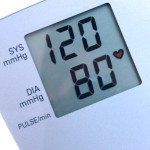Podcast 42: Will Immunity-Boosting Foods, Supplements and Super-dosing prevent COVID-19?
As we move through the rollercoaster ride of what’s been the last year and take
Just like Cardiovascular Disease and Diabetes, unless specific tests are run, Hypertension, or High Blood Pressure is something that you cannot see or feel. Hypertension can be a serious issue if not well controlled, increasing your risk of stroke, kidney disease and heart disease. On top of the fibre you include in your diet (which also help prevent and or manage heart disease and diabetes), the foods you eat, your physical activity levels, and how you handle and manage stress can positively influence your blood pressure, if the right choices are made.
As your blood moves throughout your body, the pressure of how the blood flows is measured in millimeters of mercury (mm Hg), and identifies the force of your blood against the walls of your arteries. Blood pressure is measured as 2 numbers:
1. The top number, or Systolic Pressure indicates the pressure against your artery walls when your heart is working, or contracting.
2. The lower number, or Diastolic Pressure identifies the pressure when your heart is relaxed.
Normal blood pressure falls within the range of 120/80 mm Hg and 129/84 mm Hg. If you present with a blood pressure between 130/85 mm Hg and 139/89 mm Hg, that is considered “high normal” and will most likely turn into high blood pressure (>140/90 mm Hg) if not controlled. People living with diabetes have a different target, where 130/80 mm Hg is considered “high”.
Most people associate the amount of salt they have in their diet as a main behaviour change to get under control when managing high blood pressure. It is important to recognize that when diagnosed with Hypertension, you still do need some salt in your diet, but need to carefully monitor the amount. People with Hypertension should try to keep their sodium level to 1200-1500 mg of sodium daily, or about ⅔ of a teaspoon of salt. Remember that of the sodium in our diet, about 12% comes from naturally occurring sodium in foods, 11% from what we add to our food and about 77% from processed foods!! Considering we can control the last value from processed foods, that’s where we need to give a little more attention to when shopping and reading labels. Aim to choose foods that have less than 5% of the Daily Value (% DV) of sodium per portion of a food item. The Dietary Approaches to Stop Hypertension (DASH Diet) is the main meal make-over and lifestyle approach to help those living with high blood pressure adopt healthy lifestyle behaviours to control their blood pressure. By adopting this lifestyle pattern, research has indicated that you can lower your systolic blood pressure (top number) by 16 (mm Hg) and diastolic blood pressure by 8 (mm Hg).
Including daily physical activity that raises your heart rate for 30-60 minutes has shown to reduce your systolic blood pressure by up to 5 (mm Hg) and diastolic blood pressure by 4 (mm Hg).
Watching the fat in your diet (choosing monounsaturated and polyunsaturated fats more often rather than saturated and trans fats), will also help you lose weight (if you need to). Research in this area indicates that for every kilogram of weight lost (2.2 pounds), you can lower both your systolic and diastolic blood pressure by up to 1 (mm Hg).
Most people in society today have become so accustomed to the taste of salt that they tend to add it to their food before tasting the food. Food has so many wonderful flavours on it’s own, and we just need to find it again! There are also a number of fresh and dried herbs and spices which we can add to our foods to enhance their flavour profile without harming our insides. Play around with your favourite herbs and spices to find out which one agrees with your palate the best.
 For active individuals and athletes, it is important to remember why we do need some sodium in our diet. It helps regulate our blood pressure (high levels becomes the issue), and functions in helping our nerves and muscles talk to one another. When we sweat, whether during an intense workout, or just in the heat, you do lose sodium, so it is important to replenish what you do lose and make sure your levels are adequate. Check out the resources below to find out how you can make little changes to your diet and help your body get the sodium it needs!
For active individuals and athletes, it is important to remember why we do need some sodium in our diet. It helps regulate our blood pressure (high levels becomes the issue), and functions in helping our nerves and muscles talk to one another. When we sweat, whether during an intense workout, or just in the heat, you do lose sodium, so it is important to replenish what you do lose and make sure your levels are adequate. Check out the resources below to find out how you can make little changes to your diet and help your body get the sodium it needs!
http://www.hypertension.ca
http://www.nhlbi.nih.gov/health/public/heart/hbp/dash/new_dash.pdf
As we move through the rollercoaster ride of what’s been the last year and take
The uncertainty of COVID-19 has impacted everyone differently, but from a food security perspective, many